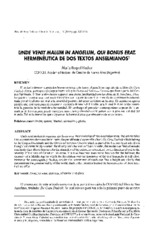Mostrar el registro sencillo del ítem
Unde venit malum in angelum, qui bonus erat. Hermenéutica de dos textos anselmianos
| dc.contributor.author | Fischer, María R | es_ES |
| dc.date.accessioned | 2022-07-04T17:25:36Z | |
| dc.date.available | 2022-07-04T17:25:36Z | |
| dc.date.issued | 2008 | |
| dc.identifier.issn | 2530-7878 | |
| dc.identifier.issn | 1133-0902 | |
| dc.identifier.uri | http://hdl.handle.net/10396/23495 | |
| dc.description.abstract | El artículo tiene en cuenta dos breves textos anselmianos: el penúltimo capítulo de su libro De Casu Diaboli el cual pertenece al Corpus Doctrinale y la Oratio ad Sanctam Crucem que forma parte del Corpus Spirituale. Si bien ambos textos suponen una cierta familiaridad con las obras de S. Anselmo, el lector puede encontrar una continuidad temática que le permite remitir el absurdo de la existencia determinada por el fatalismo del mal a la severidad postrera del amor de Cristo en la cruz. El camino se agrava porque aún está vivo para el creyente el recuerdo de una Edad Media para la cual la Revelación constituía la garantía de la verdadera humanidad. Sin embargo el pensador contemporáneo a pesar de la angostura de los caminos, puede encontrar una altura y claridad que le patenticen la genuina realidad del mundo. Tal es la intención que subyace en la hermenéutica que ofrecemos de estos textos. | es_ES |
| dc.description.abstract | Unde venit malum in angelum, qui bonus erat. Hermeneutics oftwo Anselmian texts. The article takes into account two short ansalmien texts: the penultimate chapter ofhis book De Casu Diaboli which belong to the Corpus Doctrinale and the Oratio ad Sanctam Crucem which is part ofthe Corpus Spirituale. Even though both texts imply a certain familiarity with the work of Saint Anselm, the reader can find a thematic continuity that allows him to refer the absurdity of the existance determined by the fatalism of evil to the severity of the love of Christ on his cross. The road becomes even worst because for the believer, the memory of a Middle Age to which the Revelation was the guarantee of the true humanity is still alive. However the contemporary thinker, despite the narrowness of roads can find a height and clarity that demonstrate the genuine reality of the world. Such is the intention behind the hermeneutics of these texts that we offer. | es_ES |
| dc.format.mimetype | application/pdf | es_ES |
| dc.language.iso | spa | es_ES |
| dc.publisher | UCOPress | es_ES |
| dc.rights | https://creativecommons.org/licenses/by-nc-nd/4.0/ | es_ES |
| dc.source | Revista Española de Filosofía Medieval 15, 127-136 (2008) | es_ES |
| dc.subject | Poder | es_ES |
| dc.subject | Querer | es_ES |
| dc.subject | Libertad | es_ES |
| dc.subject | Adoración y gloria | es_ES |
| dc.subject | Freedom | es_ES |
| dc.subject | Adoration and glory | es_ES |
| dc.subject | Power | es_ES |
| dc.subject | To want | es_ES |
| dc.title | Unde venit malum in angelum, qui bonus erat. Hermenéutica de dos textos anselmianos | es_ES |
| dc.title.alternative | Unde venit malum in angelum, qui bonus erat. Hermeneutics of Two Anselmian Texts | es_ES |
| dc.type | info:eu-repo/semantics/article | es_ES |
| dc.relation.publisherversion | https://www.uco.es/ucopress/ojs/index.php/refime/index | es_ES |
| dc.rights.accessRights | info:eu-repo/semantics/openAccess | es_ES |

